MDR-1RNC [GB, FR, ES] 4-448-091-51(1)
© 2012 Sony Corporation Printed in Malaysia
4-448-091-51(1)
English Noise Canceling Headphones
WARNING
Do not expose the battery to excessive heat such as direct
sunlight, fire or the like.
Excessive sound pressure from earphones and headphones
can cause hearing loss.
Notice for customers: the following
information is only applicable to equipment
sold in countries applying EU directives
The manufacturer of this product is Sony Corporation, 1-7-1
Konan Minato-ku Tokyo, 108-0075 Japan. The Authorized
Representative for EMC and product safety is Sony
Deutschland GmbH, Hedelfinger Strasse 61, 70327 Stuttgart,
Germany. For any service or guarantee matters please refer
to the addresses given in separate service or guarantee
documents.
Disposal of Old Electrical &
Electronic Equipment (Applicable
in the European Union and other
European countries with separate
collection systems)
This symbol on the product or on its packaging indicates
that this product shall not be treated as household
waste. Instead it shall be handed over to the applicable
collection point for the recycling of electrical and electronic
equipment. By ensuring this product is disposed of correctly,
you will help prevent potential negative consequences for
the environment and human health, which could otherwise
be caused by inappropriate waste handling of this product.
The recycling of materials will help to conserve natural
resources. For more detailed information about recycling
of this product, please contact your local Civic Office, your
household waste disposal service or the shop where you
purchased the product.
Disposal of waste batteries
(applicable in the European Union
and other European countries with
separate collection systems)
This symbol on the battery or on the packaging indicates
that the battery provided with this product shall not be
treated as household waste.
On certain batteries this symbol might be used in
combination with a chemical symbol. The chemical symbols
for mercury (Hg) or lead (Pb) are added if the battery
contains more than 0.0005% mercury or 0.004% lead.
By ensuring these batteries are disposed of correctly, you
will help prevent potentially negative consequences for
the environment and human health which could otherwise
be caused by inappropriate waste handling of the battery.
The recycling of the materials will help to conserve natural
resources.
In case of products that for safety, performance or data
integrity reasons require a permanent connection with an
incorporated battery, this battery should be replaced by
qualified service staff only.
To ensure that the battery will be treated properly, hand
over the product at end-of-life to the applicable collection
point for the recycling of electrical and electronic
equipment.
For all other batteries, please view the section on how
to remove the battery from the product safely. Hand the
battery over to the applicable collection point for the
recycling of waste batteries.
For more detailed information about recycling of this
product or battery, please contact your local Civic Office,
your household waste disposal service or the shop where
you purchased the product.
Checking the remaining
battery
Status POWER Indicator Beep sound
Full
Blinks 3 times *
No beep
Blinks 2 times *
No beep
Low
Blinks 1 time *
No beep
Empty Blinks quickly
(30 seconds)
Long beep
(2 seconds)
* When turning off the power of the headphones.
Checking the charging
status
Status Charging indicator
Charging On
Full Off
Charging malfunction Blinks
Using the Center button
(Inline remote and
microphone cord for
iPod/iPhone/iPad)
Operation Explanation
Single press Plays/pauses a track of the
connected iPod.
Double press Skips to the next track.
Triple press Skips to the previous track.
Long press
Starts the “VoiceOver*” feature (if
available).
Press once when call is
incoming
Answers the call.
Press again Ends the call.
Hold down for about
two seconds and
release
Rejects an incoming call (two
low beeps confirm the call was
rejected).
* Availability of the “VoiceOver” feature depends on iPod
and its software version.
Note
Be careful not to unintentionally press any buttons when
you carry your iPod with this headphones connected.
Automatic AI Noise
Canceling
The Automatic AI Noise Canceling function constantly
analyzes environmental ambient sound components and
automatically selects the most effective noise canceling
mode.
Noise canceling mode types
NC Mode A: Noise mainly in an airplane is effectively
reduced.
NC Mode B: Noise mainly in a bus or a train is effectively
reduced.
NC Mode C: Noise mainly found in an office environment
(PC, copier, air ventilation, etc.) is effectively
reduced.
Tips
When the headphones are turned on, NC Mode A is set.
It may take a few seconds to analyze the environmental
ambient sound.
Notes on use
What is noise canceling?
The noise canceling circuit actually senses outside noise
with built-in microphones and sends an equal-but-opposite
canceling signal to the headphones.
Notes on the noise canceling function
Adjust the earpads so that they cover your ears, otherwise
noise canceling will not function properly.
The noise canceling effect may vary depending on how
you wear the headphones.
Do not cover the microphone of the headphones with
your hands. The noise canceling function may not work
properly.
Microphone
After you turn on the power of the headphones, you may
hear a slight hiss. This is the operating sound of the noise
canceling function, not a malfunction.
–
–
–
–
–
–
The noise canceling function works for noise in the low
frequency band primarily. Although noise is reduced, it is
not canceled completely.
The noise canceling effect may not be pronounced in a
very quiet environment, or some noise may be heard.
When you use the headphones in a train or a car, noise
may occur depending on street conditions.
Howling may occur if you do not wear the headphones
correctly.
Howling may occur if you place an object such as finger
close to inside of the headphones. Keep it away from the
headphones.
Mobile phones may cause interference and noise. Should
this occur, locate the headphones further away from the
mobile phone.
Notes on using on the airplane
Do not use the headphones when use of electronic
equipment is prohibited or when use of personal
headphones for in-flight entertainment services is
prohibited.
Notes on charging the headphones
Charge the headphones using the supplied micro-USB
cable. Otherwise, it may cause a malfunction.
Charge in an environmental temperature of between 5°C
and 35°C. Otherwise, the battery may not fully charge.
Do not store the headphones in hot places for a long time.
When storing it for more than a year, charge the battery
once a year to prevent over discharge.
For system requirements for a computer that can charge
the battery using USB, see “System requirements for
battery charge using USB”.
If you recharge the headphones by connecting to an AC
outlet, use the separately-sold USB AC Adaptor specific in
“Recommended accessory (sold separately)”. For details,
refer to the operating instructions supplied with the
adaptor.
If the headphones are malfunctioning, charging will not
start and the charging indicator will blink. In this case,
disconnect the unit from the connected device, and
consult your place of purchase, or a Sony dealer.
Notes on handling
Because the headphones are designed to fit closely in your
ears, forcing them against your ears may result in eardrum
damage. Avoid using the headphones where they are
liable to be struck by people or other objects, such as a
ball, etc.
Pressing the headphones against your ears may produce a
diaphragm click sound. This is not a malfunction.
Clean the headphones with a soft dry cloth.
Do not leave the plug dirty otherwise the sound may be
distorted.
Be sure to consult a Sony dealer when the earpads
become dirty or damaged, or when the headphones
require repair work.
–
–
–
–
–
–
–
–
–
–
–
–
–
–
–
–
–
Do not leave the headphones in a location subject to
direct sunlight, heat or moisture.
Do not subject the headphones to excessive shock.
Handle the driver units carefully.
If you feel drowsy or sick while using this headphones,
stop use immediately.
Notes on headphones
High volume may affect your hearing. For traffic
safety, do not use while driving or cycling.
As headphones reduce outside sounds, they may cause a
traffic accident. Also, avoid listening with your headphones
in situations where hearing must not be impaired, for
example, a railroad crossing, a construction site, etc.
Preventing hearing damage
Avoid using headphones at high volume. Hearing experts
advise against continuous, loud and extended play. If you
experience a ringing in your ears, reduce the volume or
discontinue use.
Note on static electricity
In particularly dry air conditions, noise or sound skipping
may occur, or mild tingling may be felt on your ears. This is a
result of static electricity accumulated in the body, and not a
malfunction of the headphones.
The effect can be minimized by wearing clothes made from
natural materials.
If you have any questions or problems concerning the
system that are not covered in this manual, please consult
the nearest Sony dealer.
Troubleshooting
No sound
Recharge the headphones.
You can listen to the music using the headphones even
when the POWER switch is set to “OFF”. In this case, the
noise canceling function, Digital Equalizer, S-Master and
DSEE are not active, and the headphones operate as
passive headphones.
Check that the rechargeable battery is not depleted.
Check the connection of the headphones and the
equipment.
Check that the connected equipment is turned on.
Turn up the volume of the connected equipment.
The noise canceling effect is not sufficient
The noise canceling function is effective in low frequency
ranges such as airplanes, trains, or offices (near air-
conditioning, etc.) and is not as effective for higher
frequencies, such as human voices.
Turn on the headphones.
–
–
–
–
–
–
–
–
–
–
–
Distorted sound
Turn down the volume of the connected equipment.
Recharge the headphones.
Power does not turn on or the headphones
do not operate properly
Recharge the headphones.
If the power does not turn on, even after charging the
headphones, the rechargeable battery may be damaged.
In this case, consult your place of purchase or a Sony
dealer.
Charging cannot be done
Check that the charging indicator is lights up.
Connect the headphones and the micro-USB cable
securely.
Check that the micro-USB cable and the computer are
firmly connected.
Check that the micro-USB cable and the computer are
directly connected; not via a USB hub.
Check the system requirements for a computer that can
charge the battery using USB.
Check that the computer is turned on.
Check that the computer is not in standby, sleep or
hibernation mode.
If the charging indicator blinks (blinking patterns: about 30
seconds on and 3 seconds off), you are using an adaptor
other than the recommended one. Use a USB AC Adaptor
specified in “Recommended accessory (sold separately)”.
If the charging indicator blinks, the headphones may be
malfunctioning. Disconnect the unit from the connected
device, and consult your place of purchase, or a Sony
dealer.
The unit cannot be recognized by a
computer
Check that the micro-USB cable and the computer are
firmly connected.
Disconnect the micro-USB cable from the computer and
connect again.
Check that the micro-USB cable and the computer are
directly connected; not via a USB hub.
There may be a problem with the connected USB port
of the computer. Connect to another USB port if it is
available.
Try the USB connection procedure again in cases other
than those stated above.
No operation works
Set the POWER switch of the headphones to “OFF”,
confirm the connections, and then set the POWER switch
back to “ON”.
Reset the headphones.
Insert a small pin, etc. into the RESET button on the left
housing, and press until the button slightly rebounds.
The connected iPod does not work
Check if the cord is connected correctly. Connect
the L type plug to the iPod and the other plug to the
headphones.
Features
Digital Noise Canceling with Dual Noise Sensor
Technology
Microphones both inside and outside the housings are
combined with digital noise canceling software engine to
deliver significant noise canceling performance.
Automatic AI (Artificial Intelligence) Noise Canceling
function.
Automatic selection of the optimal noise canceling mode
based on intelligent analysis of environmental ambient
noise.
Digital Equalizer and full digital S-Master amplifier
Delivers ideal frequency response and high-quality music
reproduction with full digital processing.
DSEE
Offers natural sound with a spacious feel by restoring
high-frequency range sound and the tail shape of the
waveform likely to be removed through the audio
compression process.
Up to 22 hours of listening time
Passive operation
Allows audio listening even when the headphones power
is turned off.
Detachable cord
Specifications
General
Type Closed, dynamic
Driver units 50 mm, dome type
Power handling capacity
100 mW
Impedance 51 Ω at 1 kHz (when the power is on)
19 Ω at 1 kHz (when the power is off)
Sensitivity 103 dB/mW (when the power is on)
100 dB/mW (when the power is off)
Frequency response
5 Hz – 24,000 Hz
Total Noise Suppression Ratio
1)
Approx. 25 dB
2)
Power source DC 3.7 V Built-in lithium-ion rechargeable
battery or DC 5 V USB
Current consumption
500 mA
Mass Approx. 330 g (without cord)
Talk microphone Open circuit voltage level (Inline remote
and microphone cord for iPod/iPhone/iPad)
–42 dB (0 dB = 1 V/Pa)
Headphones charging and usage time
Approx. charging hours
Approx. usage hours
3)
4 hours
4)
22 hours
5)
–
–
–
–
–
–
–
–
–
–
–
–
–
–
–
–
–
–
–
–
–
–
–
–
–
–
Included items
Headphones (1)
Inline remote and microphone cord for iPod/iPhone/iPad
(1.2 m cord, using PCOCC, four-conductor gold plated L-
shaped stereo mini plug) (1)
Micro-USB cable (1.5 m) (1)
Carrying case (1)
Operating Instructions (1)
Warranty card (1)
Recommended accessory (sold separately)
6)
USB AC Adaptor: AC-UD10
1)
Under the Sony measurement standard.
2)
Equivalent to approx. 99.7% reduction of energy of sound
compared with not wearing headphones.
3)
At 1 kHz, 0.1 mW + 0.1 mW output
4)
Hours required to fully charge an empty battery
5)
Time stated above may vary, depending on the
temperature or conditions of use.
6)
Availability depends on the country.
Design and specifications are subject to change without
notice.
Compatible iPod/
iPhone/iPad models
You can use the headphones with only the following models
supporting remote control. Update your iPod, iPhone or
iPad to the latest software before use. In the Operating
Instructions, iPod, iPhone and iPad are collectively described
as “iPod” except in special cases.
iPod touch (4th generation)
iPod touch (3rd generation)
iPod touch (2nd generation)
iPod nano (6th generation)
iPod nano (5th generation)
iPod nano (4th generation)
iPod classic 120GB 160GB (2009)
iPod shuffle (4th generation)
iPod shuffle (3rd generation)
iPhone 4S
iPhone 4
iPhone 3GS
iPad (3rd generation)
iPad 2
iPad
On copyright
iPad, iPhone, iPod, iPod classic, iPod nano, iPod shuffle, and
iPod touch are trademarks of Apple Inc., registered in the
U.S. and other countries.
“Made for iPod”, “Made for iPhone”, and “Made for iPad” mean
that an electronic accessory has been designed to connect
specifically to iPod, iPhone, or iPad, respectively, and has
been certified by the developer to meet Apple performance
standards. Apple is not responsible for the operation of this
device or its compliance with safety and regulatory standards.
System requirements
for battery charge using
USB
Personal Computer with pre-installed with any of the
following operating systems and USB port:
Operating Systems
When using Windows®
Windows® 7
(Home Premium / Professional / Ultimate / Starter)
(including 64 bit version)
Windows Vista® (Service Pack 2 or later)
(Home Basic / Home Premium / Business / Ultimate)
(including 64 bit version)
Windows® XP (Service Pack 3 or later)
(Home Edition / Professional / Media Center Edition 2004 /
Media Center Edition 2005)
When using Macintosh
Mac OS X (version.10.5 or later)
Windows and Windows Vista are registered trademarks or
trademarks of Microsoft Corporation in the United States
and/or other countries.
Macintosh and Mac OS are trademarks of Apple Inc.,
registered in the U.S. and other countries.
–
–
–
–
–
–
–
–
–
–
–
–
–
–
–
–
–
Noise Canceling
Headphones
Operating Instructions
Mode d’emploi
Manual de instrucciones
GB
FR
ES
MDR-1RNC
1
2
3
How to use/Mode d’utilisation/Utilización
Charging the headphones/Chargement du casque/Cómo cargar los auriculares
Connecting/Raccordement/Conexión
Turning on the power/Mise sous tension/Encendido
4
Wearing and controlling/Port et contrôles/
Colocación y control
After use
Turn off the power of the headphones
Après utilisation
Éteignez le casque
Después del uso
Apague los auriculares
Volume+
Volume+
Volumen+
Center button
Bouton central
Botón central
Volume–
Volume–
Volumen–
Microphone
Micro
Micrófono
Charging indicator
Témoin de charge
Indicador de carga
Micro-USB cable
Micro-câble USB
Cable micro USB
Tactile dot (on the left)
Point tactile (à gauche)
Punto táctil (en el lado
izquierdo)
iPod/iPhone/iPad
iPod/iPhone/iPad
iPod/iPhone/iPad
Inline remote and microphone cord for iPod/iPhone/iPad
Cordon du micro et distant en série pour iPod/iPhone/iPad
Remoto en línea y cable de micrófono para iPod/iPhone/iPad
L indication
Indication L
Indicación L
R indication
Indication R
Indicación R

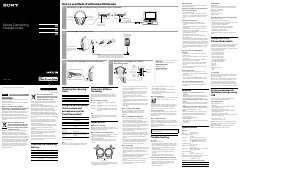


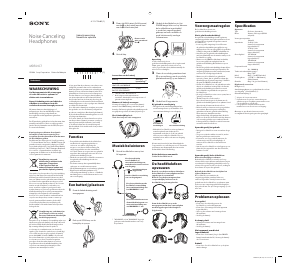


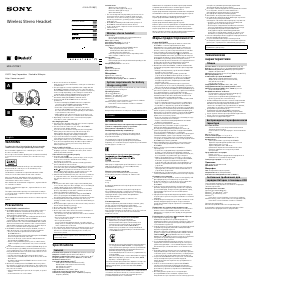
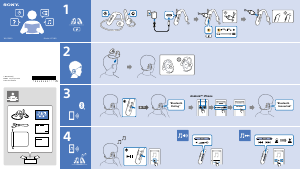
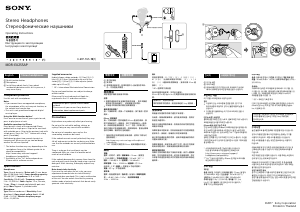
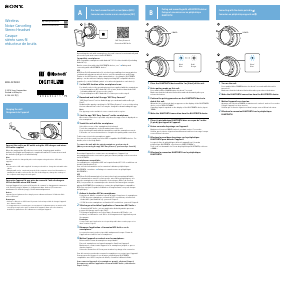

Praat mee over dit product
Laat hier weten wat jij vindt van de Sony MDR-1RNC Koptelefoon. Als je een vraag hebt, lees dan eerst zorgvuldig de handleiding door. Een handleiding aanvragen kan via ons contactformulier.